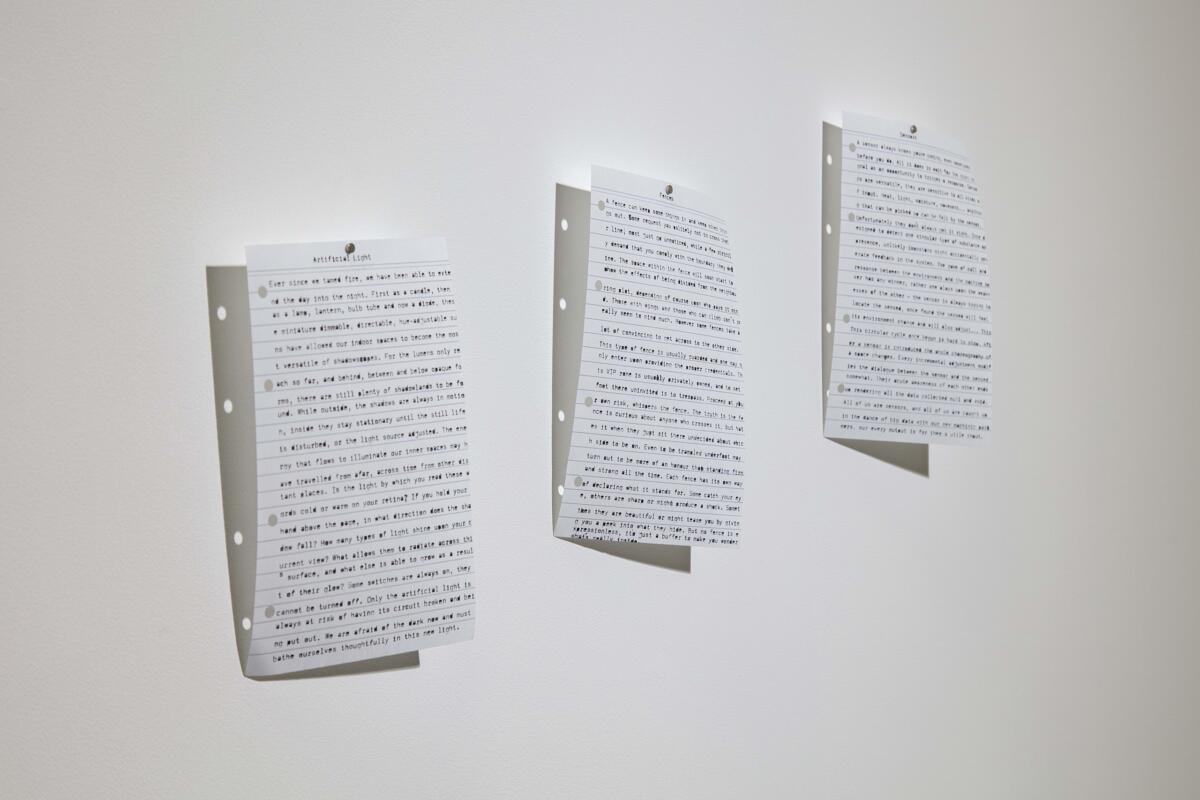‘Stasis Leak / Blasts Cries Laughter’ at Pragovka Gallery and The White Room
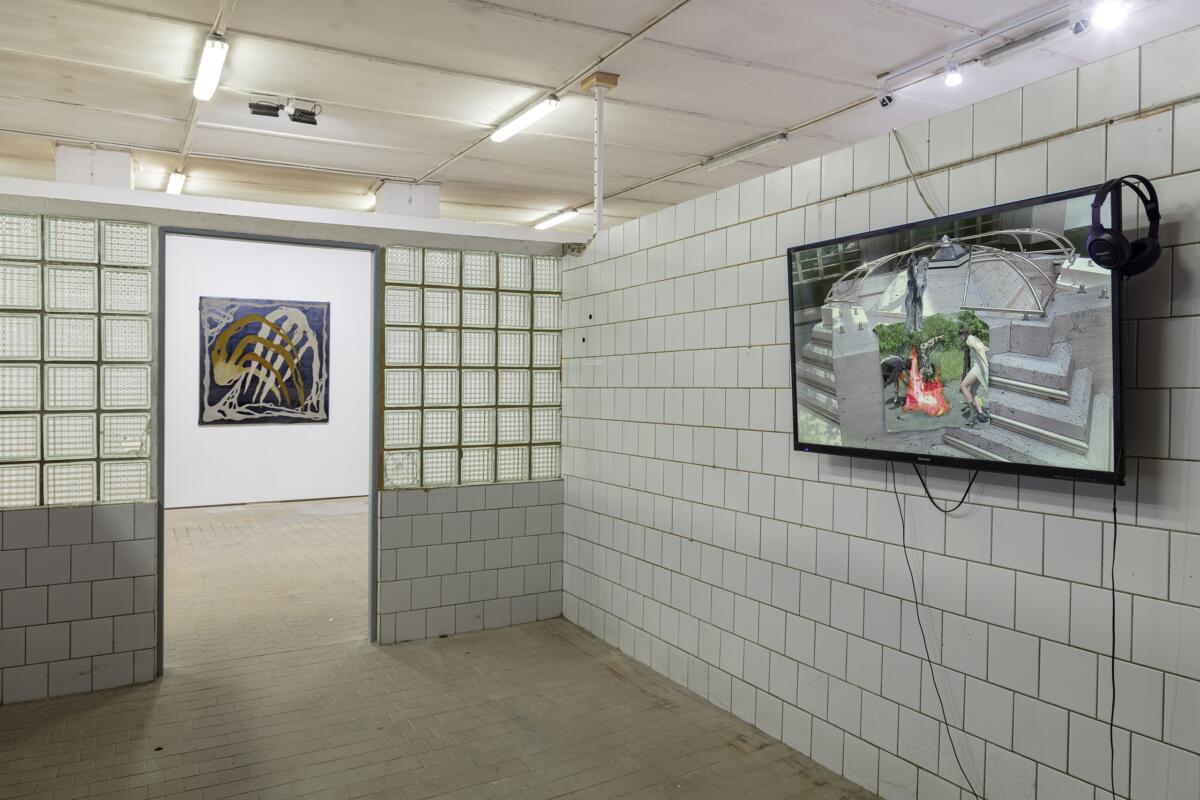
The bluish stain on the wall of the Red Dwarf’s deck had not only one exit as the creators of the TV series…but two. The second exit led to the Pragovka of January 2022 – the XXII World Dimension, to an exhibition that would be named Capturing Time and Space under different circumstances.
In this post-pandemic era, many artists have attempted to reflect on their existence in the world, and the ways in which they are anchored ‘locally, interpersonally, historically, and through sound’. In this exhibition, the mind finds itself in the site-specific terrain of installations, within the audible interventions of the factory hall. In positioning the mind in this environment, it seeks to anchor itself through participation. In defining the sonic territory of the building, and by looking back at the geological and political past, we ‘ride the dragon and are afraid to look down‘. Time and space are concepts the mind has not yet learned to handle.
We have divided the exhibition into several interlinking curatorial themes, which are not bound necessarily in space, but rather in concept.
Zachycení v čase a prostoru (Capturing Time and Space)
Prvotní zvuk a ocas chřestýše / Sdílená samota (The Primordial Sound and Tail of a Rattlesnake / Shared Solitude)
(Ne)udržitelná spojení ((Un)sustainable Connections)
Futurologivký kongres v hotelu Oáza / Blasts Cries Laughter (Futurological Congress at the OÁZA Hotel / Blasts Cries Laughter)
In these themes or acts the projects of the guest curators occupy a special place: Shared Solitude led by Tereza Nováková from the Artbiom platform and Blasts Cries Laughter led by Niccolò Lucarelli.
During the preparation of the year-round exhibition plan, we faced an important task – to select artists and guest curators through an open call and ensure the greatest possible transparency of selection. In doing this, we hoped to create an exhibition that provides a clear and comprehensive view of our topic Napojení (‘Connection’). We considered the whole year as a performance, anchored in three thematic acts; Capturing Time and Space, Digital and Morphic Fields and The Desire for Connection.
Capturing Time and Space is the theme of the first of these acts. We chose the name Díra ve stázi (Stasis Leak), inspired by the now cult series Red Dwarf. We asked ourselves ‘why is capturing time and space so important to us, and does it even make sense to for the arts to deal with this at a time of boundless networking?’.
The range of information that our limited perception allows us to capture, is always viewed from the point at which we find ourselves. As a society, our comprehension of the world around us and the pursuit of understanding, has been almost stagnant since the Renaissance. Our anchoring, which determines the angle of our perspective, is shaped by historical-geographical contexts, our knowledge at the intersection of time and space, or the depth of our sensory and extrasensory perception. The exhibition, Díra ve stázi (Stasis Leak), is an attempt to come to terms with the uncertainty of one’s own place in the world, to settle in place and time, to explore ways of understanding the isolation experienced in the last two years and how this has changed the world.
According to film theorist Paul Schrader, “stasis” is the third and therefore the last degree of transcendence. It is a frozen view of life that does not release internal tension but transcends it. The exhibition, Díra ve stázi (Stasis Leak), hopes to capture this in several ways: geologically, politically, through emotions, the mind, the body, through social relations and in personal archeology.
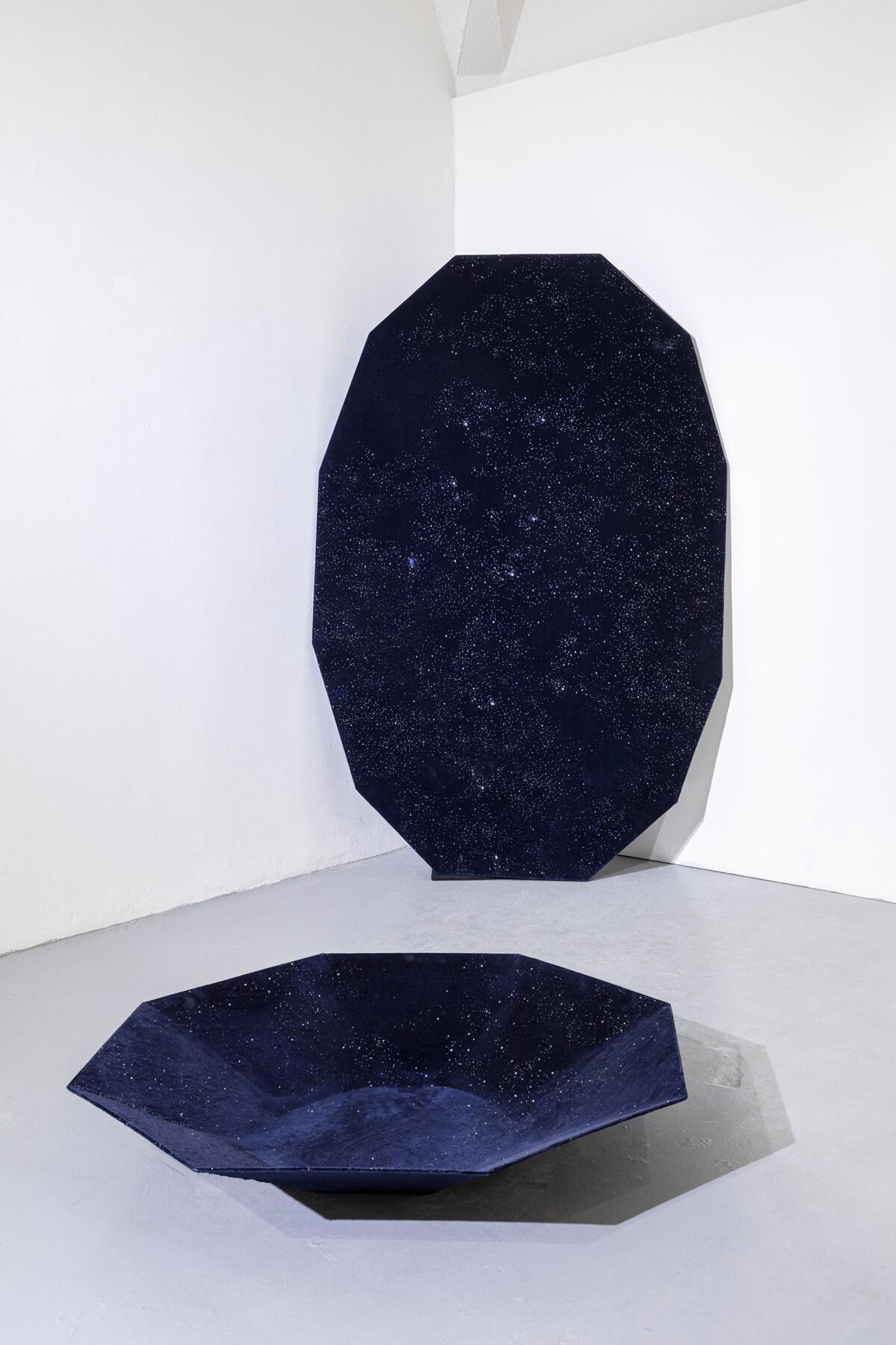
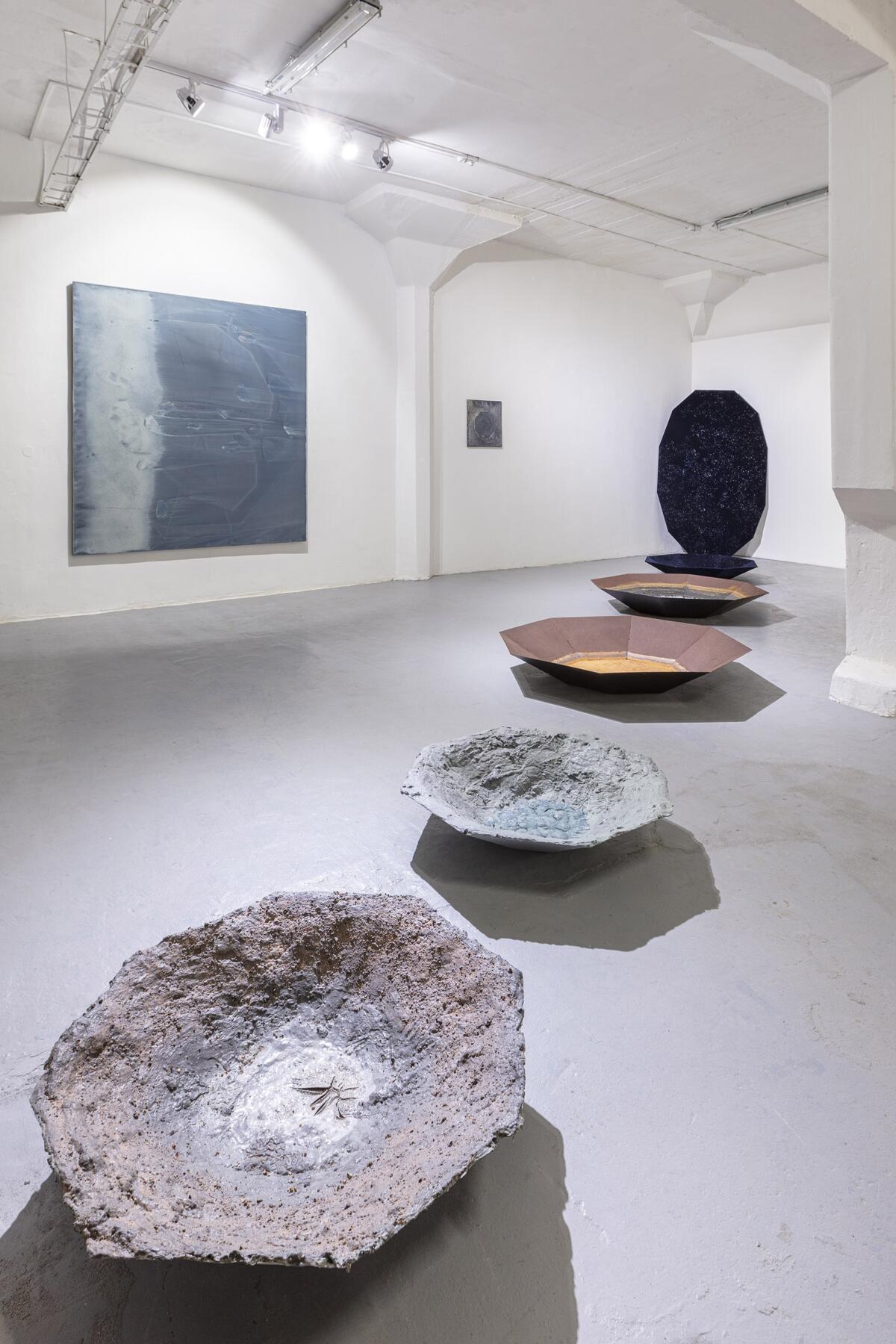
Zachycení v čase a prostoru (Capturing Time and Space) is presented in the ENTRY room and has been created by Dagmar Šubrtová from the ‘Mind in the Field’ series. This series thematizes our anthropogenic activities in geological time through working with sediments from ecologically dangerous dumps and sludge ponds. The creation of Šubrtová’s work reflects natural processes taking place in these environments. Šubrtová stops the work on paintings and objects at a moment of beauty, which often simultaneously contains a strong cosmological principle, referring to the interconnectedness of the changes as a whole. Although Šubrtová’s work seeks to have aesthetic value, its ecological statement should not be overlooked. Šubrtová conducted long-term research into heaps, lagoons, and sludge ponds, containing often dangerous poisons. In these she found a distinctive beauty that stimulated her processes in a studio that resembles that of an alchemist’s. Her experiments with sediments and minerals imitate the flow of natural mud streams and layers. From this she can form secondary minerals, in a similar way to the crystallization of copper compounds, sulfur, lead, arsenic, iron and other elements. The aesthetics of the secondary minerals evoke ambivalent feelings – the beauty of the artifacts seems to deny the dangers of the substances from which they are created. For Šubrtová, local research is also an integral part of her work. In creating this collection, she worked alongside geologist Radek Mikuláš, who has brought some of his own finding for display at Pragovka.
The slow, geological time frame of Šubrtová’s work is in sharp contrast to that by Pavol Truben. It is set during a political period, in which the imaginary duration of time forms a much shorter chapter. Through the relic of a socialist era guard ship Truben crafts an artistic message about the principles of individual responsibility in an authoritarian system. In this piece Truben seeks to both capture this moment and reflect on it. He sees his installation not only as a reference to the past, but also finds parallels with current pandemic restrictions; specifically, the closing of borders and the restricting of contacts. He relates this to shibari – a Japanese form of bonding used to restrict captives. Truben uses this bonding against a living relict of the socialist era, as a warning that everyone has an individual responsibility. However, none of us truly know how we would behave under an authoritarian regime.
In the REAR space the topic of Capturing Time and Space is followed by work from a pair of artists, Martina Chloupa and Kateřina Štenclová. According to Paul Schrader, stasis is ’a marker of transcendent art‘. It is a rift in the space-time continuum, in which time ceases to flow – like the creation or perception of some works of art. Chloupa and Štenclová meet in liquid time, within a current in which they react through expressive and translucent paintings, exploring the otherwise vague notion of translucency of being.
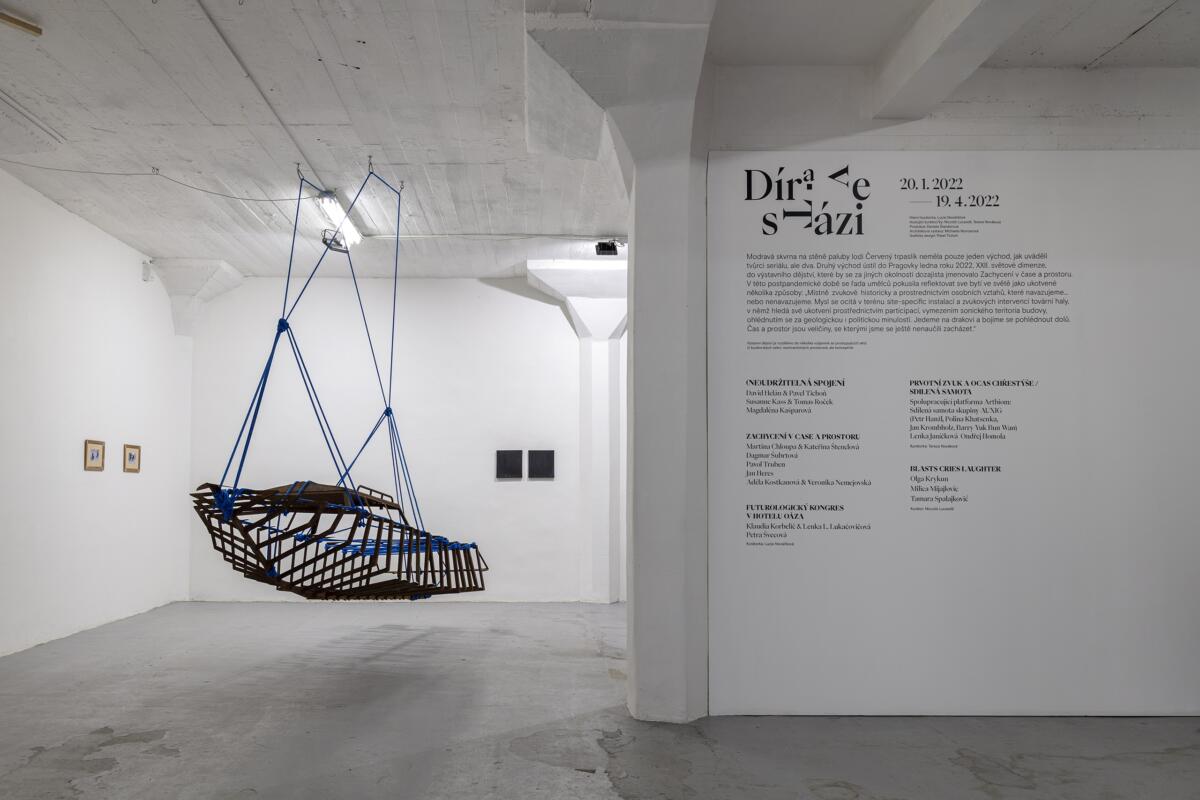
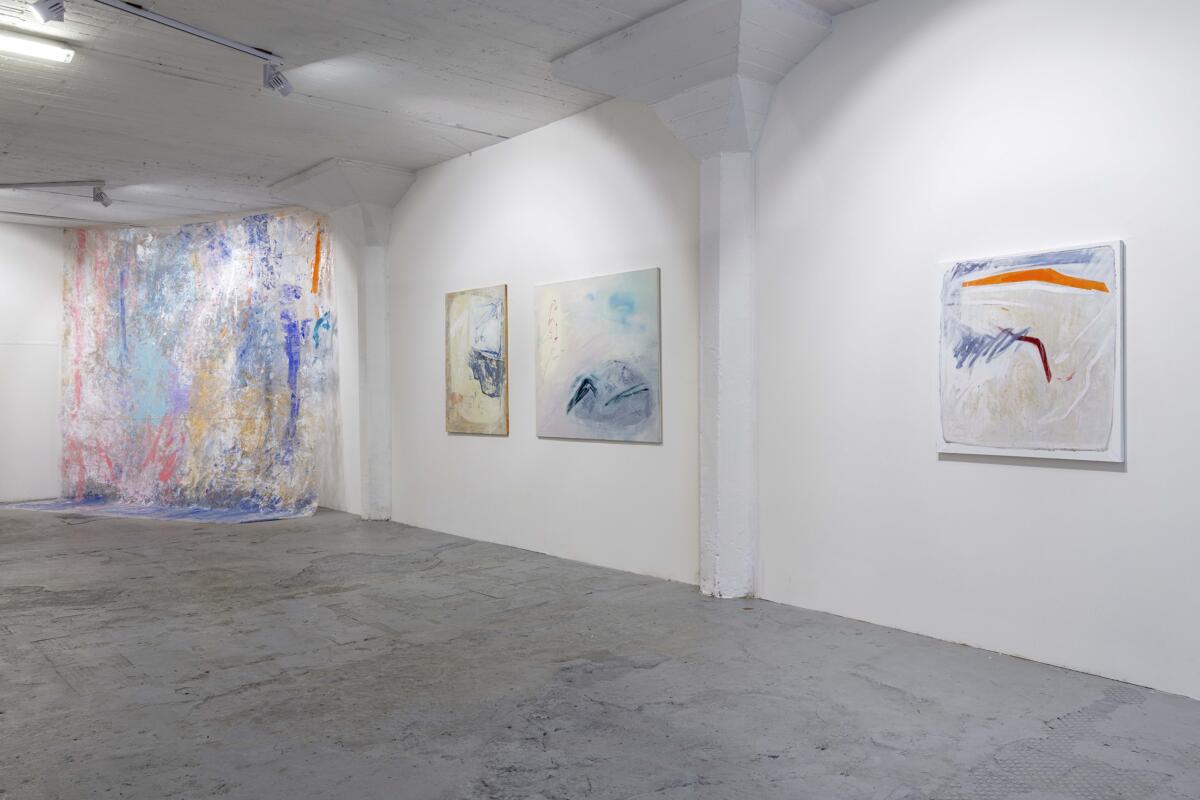

Štenclová‘s works are rooted in abstract expressionism. The starting point is often the distribution of colors and shapes captured by rapid, random movement. She assigns Taoist titles to the works; the titles often drawing from a line of the imaginary seventeen syllables, that are spread over three levels of perception (initial perception, its naming, and final form). Štenclová examines the morphology of feelings and emotions through the exploration of colours; the principles of image construction, the overlapping of motifs and the confrontation of random structures, with thoughtful inputs into the image. The connection between the process and the resulting image is presented in a series of in-situ installations. These are created intentionally, but as a natural consequence of the creative process, in the large, plastic format that she has been creating since 2005.
Expressive figuration is characteristic of Martina Chloupa’s paintings. Portraits and human torsos are created through acrylic paints – and since 2004 through painting on a nylon base colored with silicone, in which she depicts the faces or bodies of friends and family. In the context of Martina Chloupa’s work the cassation of time is a direct reference to the moment of inspiration when time is stopped to preserve an idea and may or may not be repeated in the future. If this moment returns, then it is read as a signal to further develop on the previous inspiration. Drawing from the momentary perceptions Jan Heres’ work stands in physical and conceptual contrast to the transparent, expressively tuned works on the opposite wall. Some of Heres’ early incarnations of the theories behind his paintings are exhibited here. For example, his attempt to capture the current psychological relationship to the pandemic draws inspiration from traditional Indonesian figurative motifs and rituals, while simultaneously referencing contemporary computer graphics, processed by combined brush painting and airbrush, with a strong coloristic feeling. In this work Heres stands on the border between the themes of Capturing Time and Space and (Un)Sustainable Connections.
(Ne)udržitelná spojení ((Un)Sustainable Connections) section represents the opposite of stasis. It deals with the flow, not the cessation of time. The passage of time is accentuated in Tomáš Roček’s and Susanne Kass’s project Udržitelná spojení (Sustainable Connections) which seeks to explore and create. Artists look for sustainability – not only at the level of materials, but also at the level of ‘tools’. The integral tools of this section are language, games which play with language, time spent together and retrospective reflection. The gradually emerging installation connects the present and the future through collaborative artistic practice. During the six weeks from 6. 2. to 17. 3. the designated space will come alive with the work of the main artists and their guests. The creators of Sustainable Connections describe themselves as the ‘hacker class’ and their nightmare is “creating new things over and over again, trying to push time” (McKenzie Wark – A Hacker Manifesto). Now, however, the creation of new connections is a joy, and time is pushed aside.
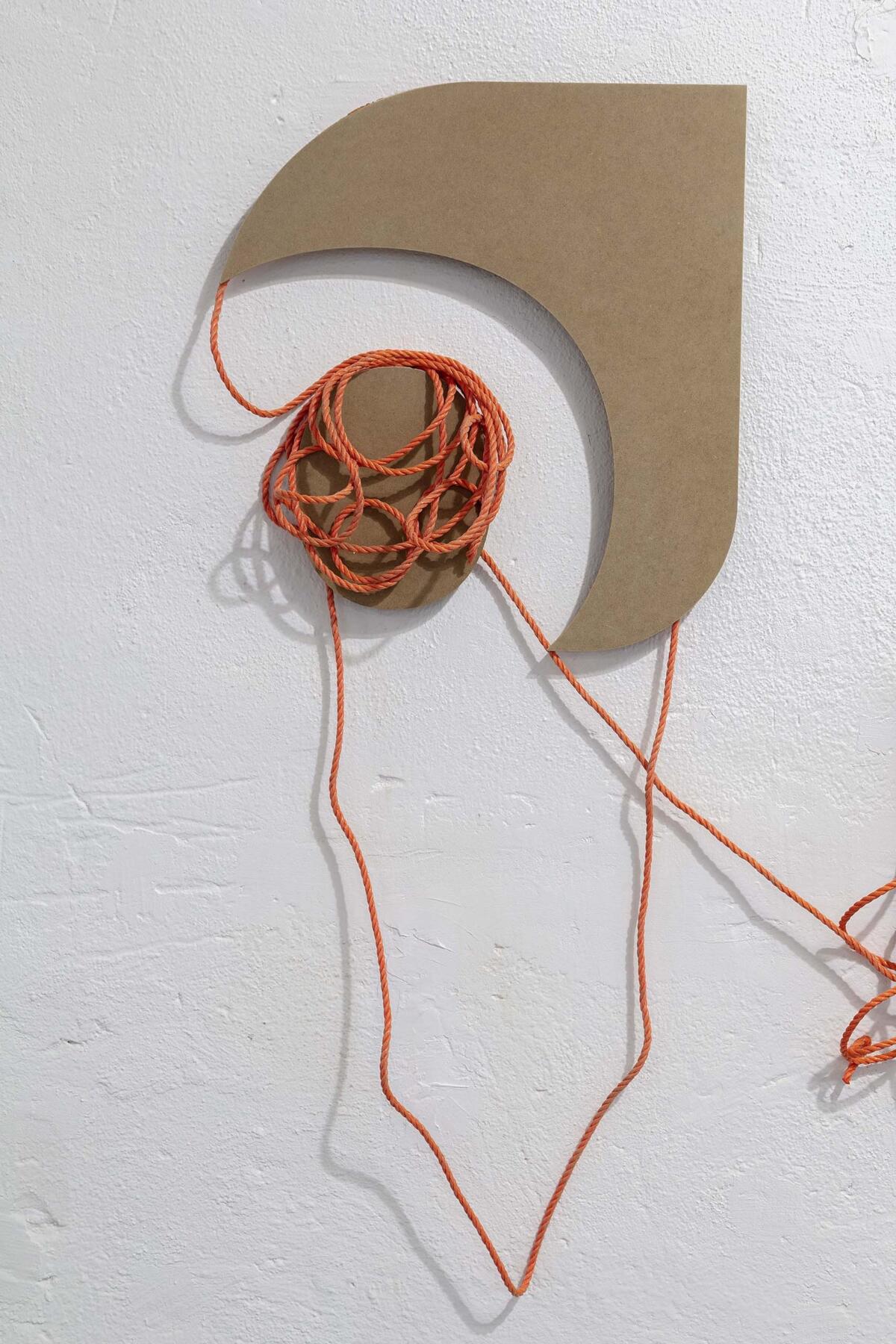
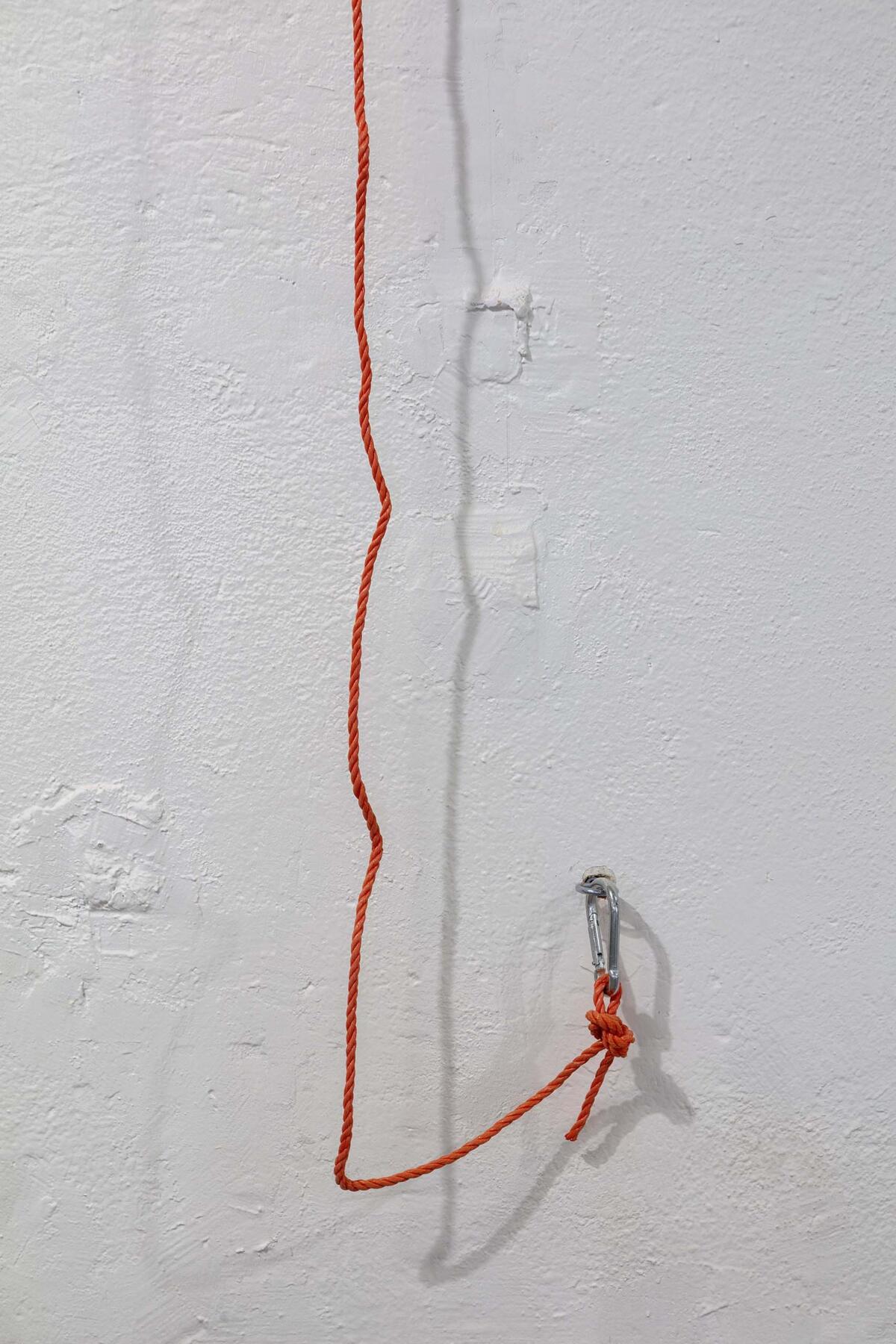
The second installation of (Un)Sustainable Connections section consists of a collaborative, linguistically subversive, Dadaistically incomprehensible project by the artistic duo David Helán–Pavel Tichoň. Hovorlezecká instalace installation Poesije? and Kapitál Němo is directly related to the ring of Arte Pověra, in which not two, but three collector traps are pitted against each other.
Maybe there is a way to get into the past. Maybe this communication is encrypted, or maybe we will react in the past as Rimmer did when he saw his own head coming off the tabletop. Perhaps it is better to participate and get out of stasis?
The imaginary center of the exhibition is an audio-reactive installation by the AUXIG group located in the only distinctive architectural element-tunnel in the REAR space. It is also the first of two curatorial sections dedicated to external curators. “The ECHO project of the AUXIG Group opens the section ‘Primordial Sound and Tail of a Rattlesnake’. ECHA’s audio-reactive generative installation reflects the gallery space and the visitor’s stay. This will be replaced by a recording of the performance, which reflects the current era of social separation and the transfer of life to a virtual environment. It is a metaphor for our desire to reconnect. The relationship of cooperation of the authors is presented in the form of a shared resonance forming the resulting soundscape. The audio-reactive installation ECHA preceded the recording of the performance Shared Solitude by the group of artists AUXIG – Petr Hanžl (CZ), Polina Khatsenka (BY), Jan Krombholz (CZ) and Barry Yuk Bun Wan (HK),”. Its curator, Tereza Nováková, wrote about Sdílená samota (Shared Solitude).
The section, Prvotní zvuk a ocas chřestýše (The Primordial Sound and Tail of the Rattlesnake), is closed by the works of Lenka Janíčková and Ondřej Homola, located at the exit of the REAR space on a large panel (Janíčková) and in a space we call Pop-Up (Homola). An image is then generated by the audio-reactive installation of the Auxig group, which responds to sounds within the space. This is the head of the snake. After exposure to danger, time slows down, a huge silence opens, and the intensity of perception increases. Here, this is represented by the imaginary tail of a rattlesnake. In the obversion cycle, Janíčková captures the moods of the day using a camera without a lens, presenting a boundless unity of perception, and referring to the very essence of photography as a technical image. Ondřej Homola, similarly reacts to sound or other often minimal perception, which he transforms into large-format drawings with a roller. The author himself compares the ordering of these perceptions into objects in space to a system of data in the cloud of our civilization. We can see it in a state of emergency consciousness, which can be caused by the sound of a rattlesnake’s tail.

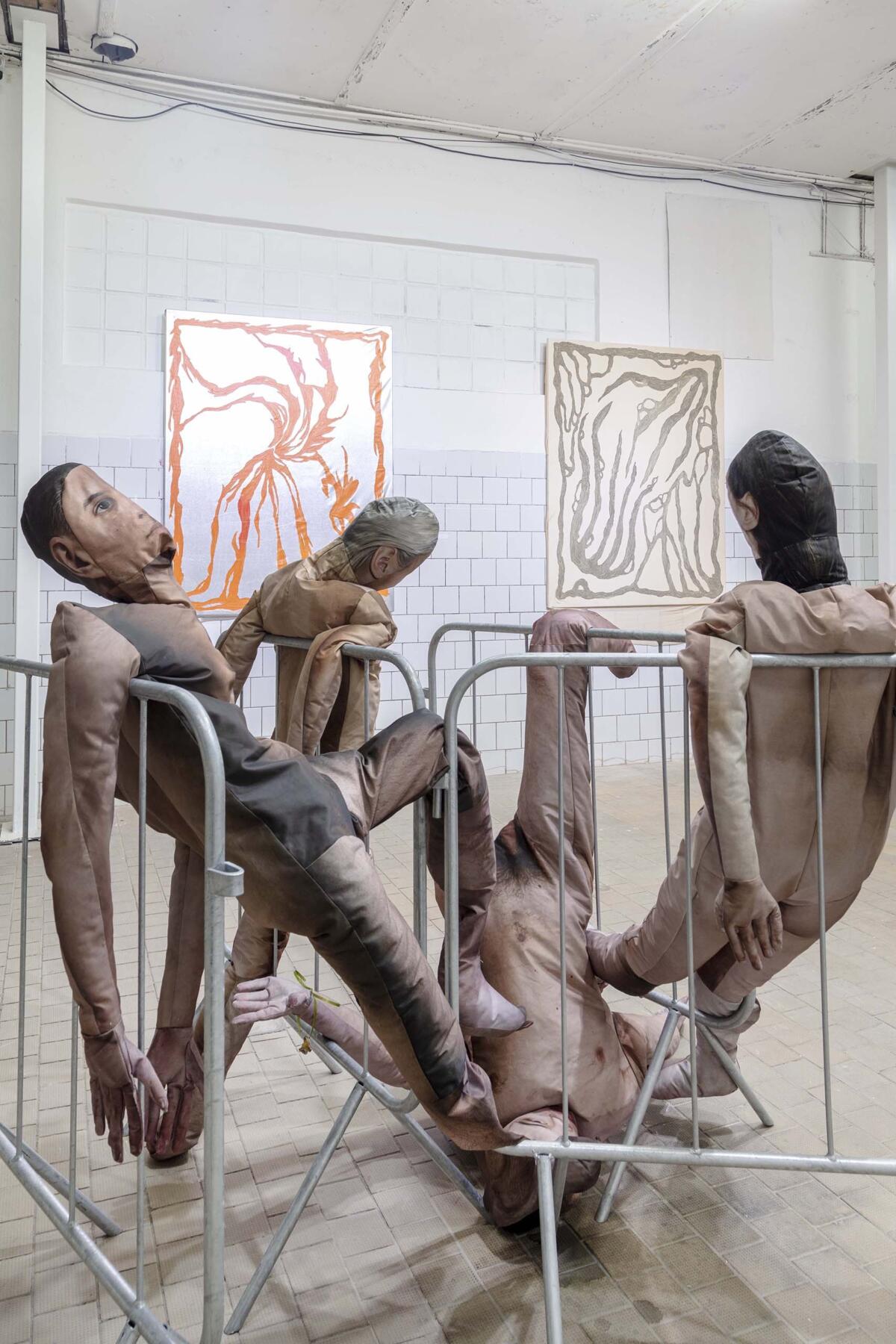
The lower part of the exhibition is closed by a section called Futurologivký kongres v hotelu Oáza (Futurological Congress in the OÁZA Hotel). The conclusion of this fictitious but famous congress is performed by Lenka L. Lukačovičová, Klaudie Korbelič and Petra Švecová in an unloving ecological vision of the world after the apocalypse. The destroyed biological laboratory of Petra Švecová investigates the world after the atomic explosion. The radiated imprint of plants opens up the space of the laboratory-greenhouse. Perhaps a long time ago – or today – someone examined the last remnants of these plants before the globe was filled with Triffids, mutated by radiation. The concept and its work have been developed by Lenka L. Lukačovičová and Klaudia Korbelič.
It is good that the crew of the Red Dwarf, a mining ship lost in space in the distant future, didn’t know about it. Setting the course toward Earth in three million years would have lost its meaning, as would the saved lives of the crew.
Equally as alarming is the second of the inline curatorial projects Blasts Cries Laughter, it is located in The White Room. Niccolò Lucarelli, the concepts director explains that Blasts Cries Laughter is conceived as a ‘drama’ on the border of tragedy and comedy, based on the ’perspective realism’ theorized by Massimo Castri, according to which the stage does not describe reality directly, but slightly distorted. A contemporary human comedy that combines demonstrations for democracy, the memory of war and a metaphorical return to silence and primordial purity to imagine a future in which people rediscover their roots, thus closing the circular path of “return to the beginnings”. This is also referred to by the title, which is a tribute to Lawrence Ferlinghetti“. The top floor of Díra ve stázi (Stasis Leak), is devoted to projects that address the topic from a greater distance. Whether it is references to political problems (Blasts Cries Laughter), the situation in health care or in personal experiences. We see these themes running through works, such as Magdalena Kašparová’s video which explores her own history; or in pieces by Adéla Kostkanová and Veronika Nemejovská which indirectly deal with themes of the pandemic.
Their work feels like a revelation in contemporary painting. The pandemic period is associated with the loss of personal, economic, and social security. In response to the isolation and related problems, the authors have been led to their own inner worlds, where no restrictions apply. For Veronika Nemejovská, insomnia and contact with the inner landscape of consciousness in the alpha state became the source. Adéla Kostkanová responded to the problems associated with social isolation and the overload of the digital world with a desire to stop. In this period the artist found her fulfillment in decaying murals, subject to destruction. These fragments often become the basis of her work. Kostkanová consolidates these parts, divides them into pieces and composes the broken mural into unique paintings. Both artists conclude Capturing Time and Space with clear reference to the overarching themes.
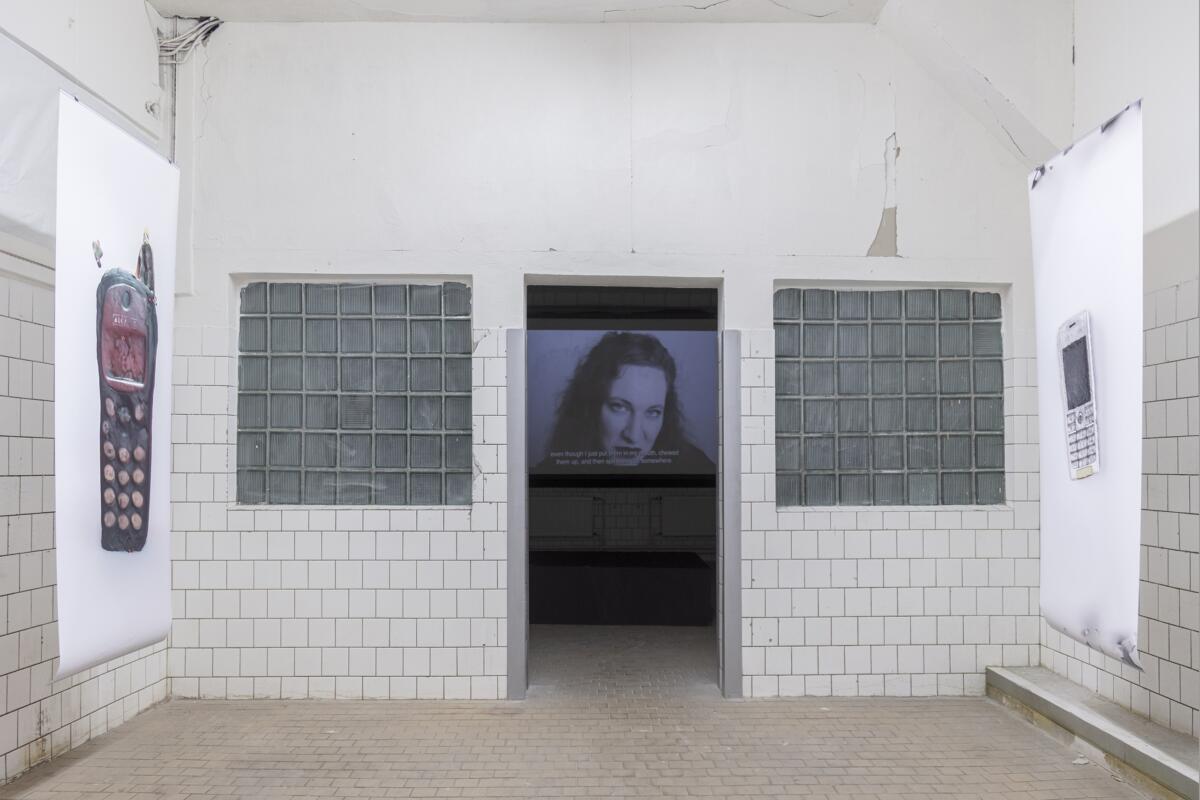


The exhibition is concluded by Magdalena Kašparová’s, My 00’s diary. This piece brings a turn, forcing reflection on the general acceptance of inner memories, in the form of female self-presentation and current performative approaches. In the installation, she evaluates her long-term interest in collecting and archiving things, often those that have personal significance for her. In the context of this exhibition, these objects represent for Magdalena a kind of ’stasis leak’, through which she enters her past. She evaluates her own coming of age story through the light-hearted medium of a vlog. The video Storytime was created with the support of the Artyčok TV platform, but from the very beginning it was planned to be projected in the physical exhibition space. Storytime uses contemporary visual language to describe the emotions associated with adolescence, such as uncertainty, anxiety, self-searching, but also excitement and enthusiasm. The form of the vlogger video is used as a tool for catharsis. From a historical point of view, girls’ memories belonged to the so-called ‘castle’, as Hana Janečková mentions in her essay ‘The End of History’. They are seen as an ‘inner delirium’. Kašparová opens the locked diary, makes it accessible and interprets it. She uses a performative approach, mixing memories with authentic videos, and referring to the standards of women’s self-presentation on social media. Sharing a deeply traumatic experience is an elegant catharsis that closes the Hole in Stasis.
Imprint
| Artist | David Helán and Pavel Tichoň, Jan Heres, Ondřej Homola, Martina Chloupa and Kateřina Štenclová, Lenka Janíčková, Susanne Kass and Tomáš Roček, Magdaléna Kašparová, Klaudia Korbelič and Lenka Lukačovičová, Adéla Kostkanová and Veronika Nemejovská, Dagmar Šubrtová, Petra Švecová, Pavol Truben |
| Exhibition | Blast Cries Laughter |
| Curated by | Lucie Nováčková, Niccolò Lucarelli, Tereza Nováková |
| Exhibition design | Daniela Šiandorová, Michaela Munzarová |
| Photos | Marcel Rozhoň |
| Website | x.pragovka.com/cs/pragovka-gallery |
| Index | Adéla Kostkanová and Veronika Nemejovská Dagmar Šubrtová Daniela Šiandorová David Helán and Pavel Tichoň Jan Heres Klaudia Korbelič and Lenka Lukačovičová Lenka Janíčková Lucie Nováčková Magdaléna Kašparová Martina Chloupa and Kateřina Štenclová Michaela Munzarová Niccolò Lucarelli Ondřej Homola Pavol Truben Petra Švecová Susanne Kass and Tomáš Roček Tereza Nováková |

